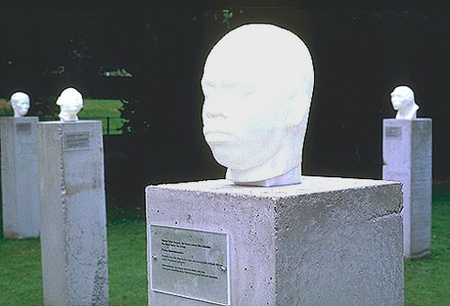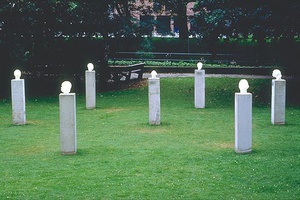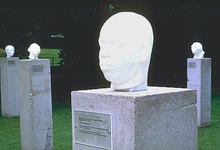Christine Borland
“Die Toten lehren die Lebenden – The Dead Teach the Living”
1997
Installation
7 concrete steles arranged over a square plot of grass bearing 7 reproductions in plastic (acrylonitrile butadiene styrene) of plaster busts and masks, study objects belonging to the anatomical collection of the University of Münster.
Signs with brief accompanying information describing the recast reproductions:
“Sinanthropus Pekinensis” (plaster bust of a reconstruction of the “China Apeman” found in the region northwest of Beijing. The original is part of the collection of the Mütter Museum in Philadelphia, USA)
“Dayak/Dyak/Dayuh” (plaster cast of a living or dead man – Dyak – from the island of Borneo. Provenance unknown)
“Clay head” (possibly the reproduction of a plaster-cast skull. Its features correspond with “typically Nordic” facial traits. Provenance unknown)
“Clay head” (possibly the reproduction of a plaster-cast skull. Its features correspond with “typically Nordic” facial traits. Provenance unknown)
“Plaster mask” (probably of a living man who might have been of South African origin. Provenance unknown)
“Plaster bust” (the bust is not of any evident anatomical or anthropological interest. Provenance unknown)
“Microcephalus Schröder” (bust in plaster of Paris, possibly of a dead person. It is unclear whether “Schröder” is the name of a child or of the person who described this particular form of the disease. The bust was purchased for the anatomical collection from a local sculptor.)
Location
Lawn flanking the Jesuitengang on the north side of St. Peter’s Church.
Temporary installation for the duration of Skulptur. Projekte in Münster 1997
Christine Borland
* 1965 in Darvel, Ayreshire, Great Britain
lives and works in different Scottish places such as Kilcreggan and Newcastle upon Tyne, Great Britain
On a lawn opposite St. Peter’s Church, where from 1781 to 1849 the first anatomy theatre of the former school for medicine and surgery in Münster once stood, Christine Borland presented seven heads made of white plastic standing on concrete steles and facing in different directions. The heads were reconstructions of plaster busts and masks from the anatomical collection of the medical faculty. The artist had the heads scanned, remodelled on the computer and finally cast in plastic.
Borland’s artistic inquiry was based on research into the historical and scientific backgrounds of hitherto incompletely documented specimens in anatomical and anthropological collections that formerly had been used for teaching medicine. The German-English title of the work translates the original Latin inscription “Mortui vivos docent”, a quote Borland adopted from the wall of the dissection theatre of the anatomical institute. The axiom expresses how important it is for research and teaching to gain new insights from preserved specimens of formerly living beings, be it death masks, plaster casts, shrunken heads or cranial bones. The idea touched on questions concerning methods and the relationship to objective reality and scientific facts, but also on the need to review and verify information about individual specimens. Borland developed a second and initially unplanned aspect of implication from the history of the institute: while researching Borland realised that early on, the Hygiene-Institut became increasingly concerned with the study of Rassenhygiene and eugenics, in accordance with the developing National Socialist doctrine. Thus, the artist generated a second, originally not intended meaning of her work: “Particularly in relation to the inscription ‘The Dead Teach the Living’ I considered the role of these professors at a time when the ever-present problematics of teaching their subject attained such epic proportions. […] the role of the professors in the NS time – some of whom became famous, some infamous according to their actions – is relatively well documented, unlike their anonymous ‘study material’ whose identity is lost.”1
While Borland did not intend her project to pass historical judgement, she nonetheless drew parallels between her artistic treatment of the history of these specimens and the evidently honest efforts by the medical faculty at Münster University to reappraise the past.2
Daniel Friedt
1 Cf. Christine Borland, “Die Toten lehren die Lebenden – The Dead Teach the Living”, in: Klaus Bußmann, Kasper König and Florian Matzner (eds.), Skulptur. Projekte in Münster 1997, exhib. cat. Westfälisches Landesmuseum für Kunst und Kulturgeschichte, Münster, Ostfildern-Ruit, 1997, pp. 72–77, here p. 75.
2 Ibid., p. 76
Images
Location
- Still existing / Public Collection
- Removed
- In the museum


